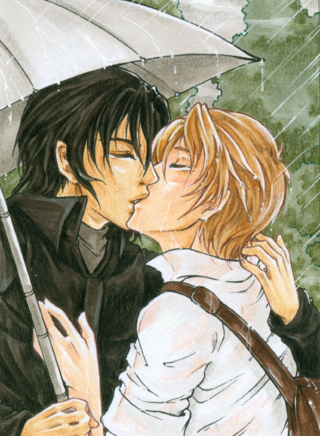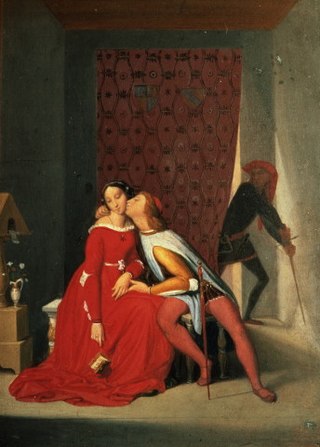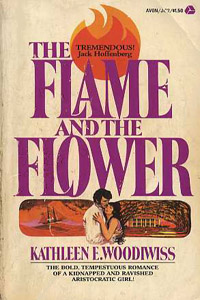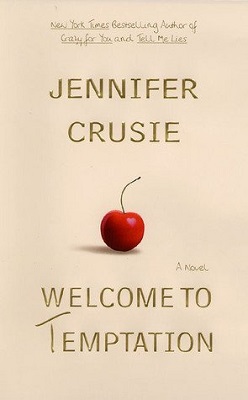
Yaoi, also known as boys' love and its abbreviation BL, is a genre of fictional media originating in Japan that features homoerotic relationships between male characters. It is typically created by women for women and is thus distinct from bara, a genre of homoerotic media marketed to gay men, though yaoi does also attract a male audience and can be produced by male creators. Yaoi spans a wide range of media, including manga, anime, drama CDs, novels, video games, television series, films, and fan works. While "yaoi" is commonly used in the west as an umbrella term for Japanese-influenced media with male-male relationships, "boys' love" and "BL" are the generic terms for this kind of media in Japan and much of Asia.

A love triangle or eternal triangle is a scenario or circumstance, usually depicted as a rivalry, in which two people are pursuing or involved in a romantic relationship with one person, or in which one person in a romantic relationship with someone is simultaneously pursuing or involved in a romantic relationship with someone else. A love triangle typically is not conceived of as a situation in which one person loves a second person, who loves a third person, who loves the first person, or variations thereof.

A romance novel or romantic novel is a genre fiction novel that primary focuses on the relationship and romantic love between two people, typically with an emotionally satisfying and optimistic ending. Authors who have contributed to the development of this genre include Samuel Richardson, Jane Austen, and Charlotte Brontë.

A sexual fantasy or erotic fantasy is an autoerotic mental image or pattern of thought that stirs a person's sexuality and can create or enhance sexual arousal. A sexual fantasy can be created by the person's imagination or memory, and may be triggered autonomously or by external stimulation such as erotic literature or pornography, a physical object, or sexual attraction to another person. Anything that may give rise to a sexual arousal may also produce a sexual fantasy, and sexual arousal may in turn give rise to fantasies.

Erotic literature comprises fictional and factual stories and accounts of eros intended to arouse similar feelings in readers. This contrasts erotica, which focuses more specifically on sexual feelings. Other common elements are satire and social criticism. Much erotic literature features erotic art, illustrating the text.

Eros is a concept in ancient Greek philosophy referring to sensual or passionate love, from which the term erotic is derived. Eros has also been used in philosophy and psychology in a much wider sense, almost as an equivalent to "life energy". The Protestant philosopher C. S. Lewis posits it as one of the four ancient Greek words for love in Christianity, alongside storge, philia, and agape.
A rape fantasy or a ravishment is a sexual fantasy involving imagining or pretending being coerced or forcefully coercing another into sexual activity. In sexual roleplay, it involves acting out roles of coercive sex. Rape pornography is literature or images associated with rape and sometimes Stockholm syndrome as a means of sexual arousal.

Erotic horror, alternately called horror erotica or dark erotica, is a term applied to works of fiction in which sensual or sexual imagery are blended with horrific overtones or story elements for the sake of sexual titillation. Horror fiction of this type is most common in literature and film. Erotic horror films are a cornerstone of Spanish and French horror.
The Lustful Turk, or Lascivious Scenes from a Harem is a pre-Victorian British exploitation erotic epistolary novel first published anonymously in 1828 by John Benjamin Brookes and reprinted by William Dugdale. However, it was not widely known or circulated until the 1893 edition.

The World's Desire is a fantasy novel first published in 1890 and written by H. Rider Haggard and Andrew Lang. It was published in paperback by Ballantine Books as the fortieth volume of the Ballantine Adult Fantasy series in January 1972.

Homosexuality in ancient Rome often differs markedly from the contemporary West. Latin lacks words that would precisely translate "homosexual" and "heterosexual". The primary dichotomy of ancient Roman sexuality was active / dominant / masculine and passive / submissive / feminine. Roman society was patriarchal, and the freeborn male citizen possessed political liberty (libertas) and the right to rule both himself and his household (familia). "Virtue" (virtus) was seen as an active quality through which a man (vir) defined himself. The conquest mentality and "cult of virility" shaped same-sex relations. Roman men were free to enjoy sex with other males without a perceived loss of masculinity or social status as long as they took the dominant or penetrative role. Acceptable male partners were slaves and former slaves, prostitutes, and entertainers, whose lifestyle placed them in the nebulous social realm of infamia, so they were excluded from the normal protections accorded to a citizen even if they were technically free. Freeborn male minors were off limits at certain periods in Rome.
The concept of rape, both as an abduction and in the sexual sense, makes its appearance in early religious texts.

The Sheik is a 1919 novel by English writer E. M. Hull. It was the first of a series of novels she wrote with desert settings that set off a major revival of the "desert romance" genre of romantic fiction. It was a huge best-seller and the most popular of her books, and it served as the basis for the film of the same name starring the Italian actor Rudolph Valentino in the title role.
Violet Winspear was a British writer of 70 romance novels in Mills & Boon from 1961 to 1987.

Historical romance is a broad category of mass-market fiction focusing on romantic relationships in historical periods, which Walter Scott helped popularize in the early 19th century.

The Flame and the Flower is the debut work of romance novelist Kathleen E. Woodiwiss. The first modern "bodice ripper" romance novel, the book revolutionized the historical romance genre. It was also the first full-length romance novel to be published first in paperback rather than hardback.
Raptio is a Latin term for, among several other meanings for senses of "taking", the large-scale abduction of women: kidnapping for marriage, concubinage or sexual slavery. The equivalent German term is Frauenraub.

The woman's film is a film genre which includes women-centered narratives, female protagonists and is designed to appeal to a female audience. Woman's films usually portray stereotypical women's concerns such as domestic life, family, motherhood, self-sacrifice, and romance. These films were produced from the silent era through the 1950s and early 1960s, but were most popular in the 1930s and 1940s, reaching their zenith during World War II. Although Hollywood continued to make films characterized by some of the elements of the traditional woman's film in the second half of the 20th century, the term itself disappeared in the 1960s. The work of directors George Cukor, Douglas Sirk, Max Ophüls, and Josef von Sternberg has been associated with the woman's film genre. Joan Crawford, Bette Davis, and Barbara Stanwyck were some of the genre's most prolific stars.

Welcome to Temptation is a contemporary romance written by Jennifer Crusie and released in 2000. The novel explores the love story between Sophie Dempsey, a screenwriter making a movie in the small town of Temptation, and the mayor, Phinneas "Phin" Tucker. Over the course of the story, they solve a murder and deal with conflict around Sophie's movie, which is alternately a documentary or a porn flick. The lead characters appear in supporting roles in the sequel, Faking It, which centers on Sophie's brother, a secondary character in Welcome to Temptation.

Victorian erotica is a genre of sexual art and literature which emerged in the Victorian era of 19th-century Britain. Victorian erotica emerged as a product of a Victorian sexual culture. The Victorian era was characterized by paradox of rigid morality and anti-sensualism, but also by an obsession with sex. Sex was a main social topic, with progressive and enlightened thought pushing for sexual restriction and repression. Overpopulation was a societal concern for the Victorians, thought to be the cause of famine, disease, and war. To curb the threats of overpopulation and to solve other social issues that were arising at the time, sex was socially regulated and controlled. New sexual categories emerged as a response, defining normal and abnormal sex. Heterosexual sex between married couples became the only form of sex socially and morally permissible. Sexual pleasure and desire beyond heterosexual marriage was labelled as deviant, considered to be sinful and sinister. Such deviant forms included masturbation, homosexuality, prostitution and pornography. Procreation was the primary goal of sex, removing it from the public, and placing it in the domestic. Yet, Victorian anti-sexual attitudes were contradictory of genuine Victorian life, with sex underlying much of the cultural practice. Sex was simultaneously repressed and proliferated. Sex was featured in medical manuals such as The Sexual Impulse by Havelock Ellis and Functions and Disorders of Reproductive Organs by William Acton, and in cultural magazines like The Penny Magazine and The Rambler. Sex was popular in entertainment, with much of Victorian theatre, art and literature including and expressing sexual and sensual themes.














